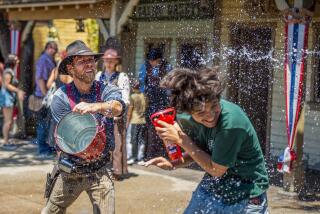Knott’s Watchdog Has Teeth
A recent state report on a fatal accident in September at Knott’s Berry Farm serves as a wake-up call for the local amusement park and a report card for others on the state’s 2-year-old legislation designed to improve theme park safety.
The state Department of Occupational Safety and Health was right to insist on review and changes in the Perilous Plunge ride and a new training program for park employees as a condition of reopening the ride.
An attraction billed as the world’s steepest and highest flume ride may quicken the hearts of thrill seekers, but the public has an obvious interest in having such an attraction be safe as well.
The Sept. 21 accident, in which a 40-year-old Duarte woman who weighed 292 pounds flew out of the ride, raised questions about the adequacy of safety restraints, as well as park standards and oversight.
The department has the authority to investigate accidents and order safety changes under the provisions of the 2000 state law, which was enacted after years of haggling between the theme park industry and consumer advocates. How each accident is investigated becomes a test of how well served the public is as the new legislation plays out. In this instance, the department appears to have done a credible job of enforcement and standard-setting, which should bolster public confidence in subsequent cases that come before it for review.
In its investigation, the department went so far as to question whether the problems with the ride’s safety restraints were restricted only to the weight of the rider, which was the focus of much of the initial inquiry. The ride has an individual T-shaped lap bar, a seat belt, and a separate grab bar. The department’s review expressed misgivings about the adequacy of the restraint system and the placement of the restraints, which allowed a person to slip out of the ride.
Investigators also found that there were no written instructions from the manufacturer for handling passengers whose physical characteristics might affect their safety.
The early reaction of Knott’s Berry Farm was encouraging. It called the report fair and thorough, and said it would do whatever it took to make the ride safe. That included insisting that the manufacturer take necessary steps to improve the safety of restraints.
What’s clear from this and other recent cases is that ride safety at amusement parks is influenced by how conscientious several interested parties within the industry are, and how well they work together to advance safety. Manufacturers must provide good, safe restraints and be willing to modify them when necessary. They must give clear instructions and training to operators, and operators must ensure that the ride operators are well-trained. Finally, consumers have a role to play themselves in not making choices that may put their health and safety at risk.
It’s too bad that reform and change come after and not before a tragedy occurs. But if the reforms are inching along, and if it has taken far too long to get to this point, at least there is some progress.
For too long, the risk was dumped on the customer, without adequate oversight or review by the state. One lesson from the experience of this ride may be that a different kind of ride harness is needed, and that there have to be more restrictions on who is allowed to ride.
This kind of fine-tuning ultimately can lead to a safer and more fun experience for the consumer.
More to Read
Sign up for Essential California
The most important California stories and recommendations in your inbox every morning.
You may occasionally receive promotional content from the Los Angeles Times.










